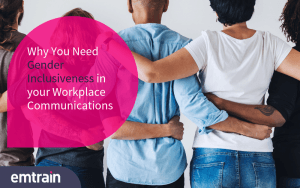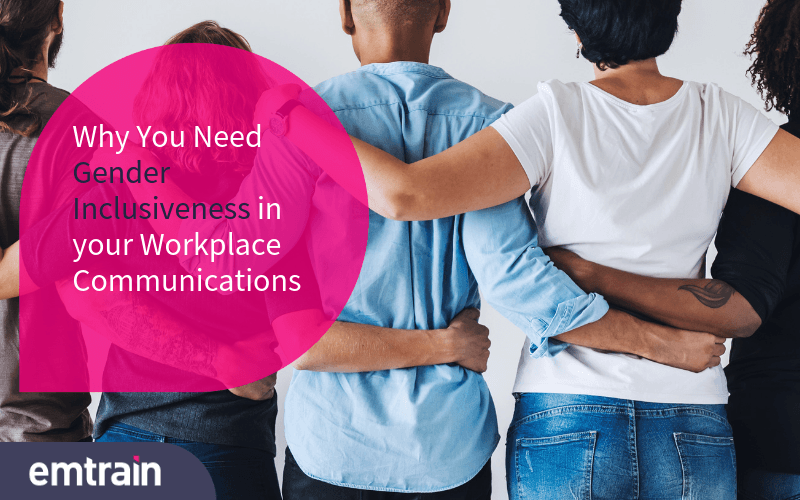Companies are increasingly investing in diversity and inclusion programs, racing to overhaul decades of systemic inequalities and recruit and retain top talent, regardless of background. One component of a company’s culture may be overlooked in this process, though, and it’s one that impacts an employee’s entire lifecycle at your company: gender-biased language.
Unless your company strives to be a bro-centric culture with male-focused everything, there are many simple changes you can make in your company language to enable a more inclusive environment.

What is Gender-Neutral Language, And Why Does It Matter?
Gendered language is anything that unnecessarily differentiates between women and men. What do you picture when you read these words or phrases: mankind, businessman and manpower, and “hey guys, we need to man up.”
Most people picture men when hearing the above words, and over time this has developed an unconscious bias that someone who portrays masculine qualities is the right fit for certain roles or that men carry some intrinsic value.
As a business communicator, company leader, or respectful colleague, it’s crucial to communicate clearly and effectively, and that includes being conscious of the impact of every word you choose. There are an array of gender identities in this world, and when society chooses to perpetuate gender-biased language, it continues to shape a world where men are the focus.
Studies have even shown that gendered language is correlated with a negative impact on a society’s overall gender equality, and any conscious efforts to stop this help reshape society.
A Gender-Neutral Language Cheat Sheet
The first step to adopting a more inclusive language set is knowing what terms may carry a different weight than intended. This cheat sheet identifies words or phrases you should swap out for more inclusive alternates.
The most basic of these is switching gendered pronouns like “he” and “she” for the singular “they.” This is often met with eye-rolls, but Merriam-Webster has deemed the singular “they” as preferable, and the organization has been around since 1828. If it can change, so can you.
This chart is not exhaustive, and your team should keep a living document to add to as more problematic terms arise, but this is a solid foundation to kickstart your awareness:
Gender-Neutral Language Cheat Sheet |
|
| Instead of Using This | Use This |
| businessman/businesswoman | business person, business professional |
| chairman/chairwoman | chair, chairperson |
| “don’t get your panties in a bunch.” | “You sound like you may be stressed or feeling overwhelmed; is there anything I can do to help?” |
| fireman/firewoman | firefighter |
| he/she, him/her, his/hers | they, them, their |
| “hey guys”/“how are you guys doing?” | Unless it’s a group of just men, say “hey everyone” or “how are you all doing?” |
| mailman/mailwoman | mail carrier |
| “man up”/“are you man enough?” | “Are you up for the challenge?” |
| mankind | humankind, humanity |
| manning | staffing |
| manpower | team, workforce |
| Mr./Ms./Mrs./Miss | Don’t use them. If you do, default to Mr. or Ms. if you are positive of someone’s desired pronoun. |
| “nut up or shut up” | “We’ll need all hands on deck for this, do you think you can support?” |
| policeman/policewoman | police officer |
| “put on your big boy/girl pants” | “Let’s work through this together” |
| “right man for the job” | “right person for the job” |
| salesman | salesperson |
| steward/stewardess | flight attendant |
| waiter/waitress | server |
Areas to Assess for Inclusivity
Once you become aware of the problematic words and phrases, it’s time to do a scrub of your company’s communications. There are a few key areas to assess to ensure inclusivity:
- Job Ads or Descriptions: For prospective employees, a job ad or description may be the first impression of your company culture. Avoid gendered pronouns in your language, as well as gendered-charged words or phrases. At a minimum, you can use this Gender Decoder for a quick sweep, but you want to ensure the phrasing is as inclusive as possible.
- Company Mission/Values: Your company mission and values are the foundation of your business, and you should review the language in them to ensure inclusivity.
- Office Signage & Decor Elements: Anything posted in your office carries a subliminal message of what is acceptable for workplace communication. Avoid gendered language in any signage, even if it’s just a temporary communication or announcement.
In some states like California, there are laws associated with the protection of employees across the gender identity and gender expression spectrum. Regardless of if your company is law-bound, these are additional areas to assess to ensure your culture is inclusive.
Examples of Gender-Neutral Language In Use
Implementing changes will take time, but it does not need to be an arduous undertaking.
Simply bringing awareness around the topic is a step in the right direction, and there are several easy and practical ways that you can roll out changes:
- Make a “Guys” Jar: Hotjar realized how often its team was using ‘guys’ in everyday conversation, so they came up with a game to draw attention to its frequency and discourage the team from using it. Like a swear jar, Hotjarians had to donate a dollar each time they used the term ‘guys’.
- Include Preferred Pronouns in Email Signatures: Even if you adopt the singular they, pronouns will still inevitably slip into conversations or email threads. Promote a people-focused culture by having a “Preferred Pronouns” line in email signatures. The UCSF LGBT Resource Center has a few options you can explore.
- Avoid Courtesy Titles: Mr., Ms., and Mrs. carry more weight than you may realize. For men, Mr. is a catch-all that is independent of marital status. Mrs. and Ms., however, carry different meanings, and different implications for women at work. One-third of married women will remove their wedding rings before an interview to remove any bias related to assumptions about future pregnancies (because every married woman will certainly have a child). There are also stereotypes associated with single women of all ages, and unmarried older women are especially prone to bias (because a woman’s value is directly correlated with her youth and ability to find a partner). For all these reasons, avoid courtesy titles whenever possible.
Fully Invest in Workplace Equality
Adopting a gender inclusive communication/language is a critical step not just for a company to advance its inclusion efforts, but for society as a whole.
Seemingly common word choice can shape future generations. All it takes is acknowledging this, and sharing a commitment to making the world a more inclusive place.
Language is a core part of your company’s culture, and an outside perspective can help identify whether it is contributing to your workplace drama. If you’re committed to making your company more inclusive, you should consider bringing in experts like Emtrain, who can assess your company language and its impact on your team. They’re here to partner with you to create a healthy, authentic culture where everyone has the potential to thrive.








